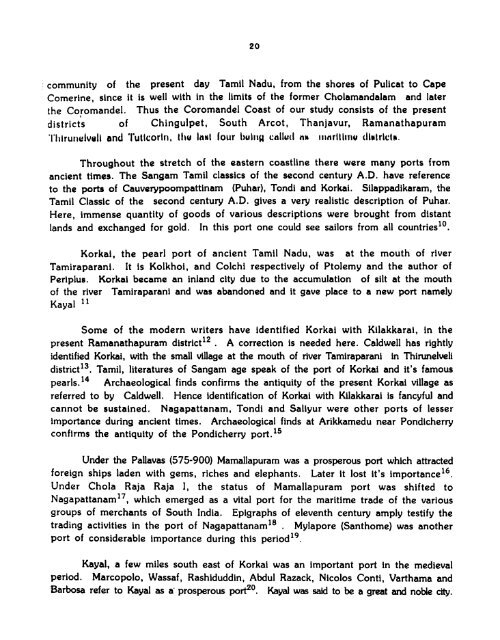maritime activities economy and social customs of the muslims of ...
maritime activities economy and social customs of the muslims of ...
maritime activities economy and social customs of the muslims of ...
Create successful ePaper yourself
Turn your PDF publications into a flip-book with our unique Google optimized e-Paper software.
community <strong>of</strong> <strong>the</strong> present day Tamil Nadu, from <strong>the</strong> shores <strong>of</strong> Pulicat to Cape<br />
Comerine, since it is well with in <strong>the</strong> limits <strong>of</strong> <strong>the</strong> former Cholam<strong>and</strong>alam <strong>and</strong> later<br />
<strong>the</strong> Co~om<strong>and</strong>el. Thus <strong>the</strong> Corom<strong>and</strong>el Coast <strong>of</strong> our study consists <strong>of</strong> <strong>the</strong> present<br />
districts <strong>of</strong> Chingulpet, South Arcot, Thanjavur, Ramanathapuram<br />
'I'l~iru~~elvull <strong>and</strong> 'l'utlcorlr~, Il~u laal lour t)ul~~u callutl nu 111nrll1111u tllrlrlclw.<br />
Throughout <strong>the</strong> stretch <strong>of</strong> <strong>the</strong> eastern coastline <strong>the</strong>re were many ports from<br />
ancient times. The Sangam Tamil classics <strong>of</strong> <strong>the</strong> second century A.D. have reference<br />
to <strong>the</strong> ports <strong>of</strong> Cauverypoompattinam (Puhar), Tondi <strong>and</strong> Korkai. Silappadikaram, <strong>the</strong><br />
Tamil Classic <strong>of</strong> <strong>the</strong> second century A.D. gives a very realistic description <strong>of</strong> Puhar.<br />
Here, immense quantity <strong>of</strong> goods <strong>of</strong> various descriptions were brought from distant<br />
l<strong>and</strong>s <strong>and</strong> exchanged for gold. In this port one could see sailors from all countrieslO.<br />
Korkai, <strong>the</strong> pearl port <strong>of</strong> ancient Tamil Nadu, was at <strong>the</strong> mouth <strong>of</strong> river<br />
Tamiraparani. It is Kolkhol, <strong>and</strong> Colchi respectively <strong>of</strong> Ptolemy <strong>and</strong> <strong>the</strong> author <strong>of</strong><br />
Peripius. Korkai became an inl<strong>and</strong> city due to <strong>the</strong> accumulation <strong>of</strong> silt at <strong>the</strong> mouth<br />
<strong>of</strong> <strong>the</strong> river Tamiraparani <strong>and</strong> was ab<strong>and</strong>oned <strong>and</strong> it gave place to a new port namely<br />
Kayai l'<br />
Some <strong>of</strong> <strong>the</strong> modern writers have identified Korkai with Kilakkarai, in <strong>the</strong><br />
present Ramanathapuram district12 . A correction is needed here. Caldwell has rightly<br />
identified Korkai, with <strong>the</strong> small village at <strong>the</strong> mouth <strong>of</strong> river Tamiraparanl in Thirunelwli<br />
district13. Tamil, literatures <strong>of</strong> Sangam age speak <strong>of</strong> <strong>the</strong> port <strong>of</strong> Korkai <strong>and</strong> it's famous<br />
pearls.'4 Archaeological finds confirms <strong>the</strong> antiquity <strong>of</strong> <strong>the</strong> present Korkai village as<br />
referred to by Caldwell. Hence identification <strong>of</strong> Korkai with Kilakkarai is fancyful <strong>and</strong><br />
cannot be sustained. Nagapattanam, Tondi <strong>and</strong> Saliyur were o<strong>the</strong>r ports <strong>of</strong> lesser<br />
importance during ancient times. Archaeological finds at Arikkamedu near Pondicherry<br />
confirms <strong>the</strong> antiquity <strong>of</strong> <strong>the</strong> Pondicherry port.'5<br />
Under <strong>the</strong> Pallavas (575-900) Mamallapuram was a prosperous port which attracted<br />
foreign ships laden with gems, riches <strong>and</strong> elephants. Later it lost it's importance16.<br />
Under Chola Raja Raja I, <strong>the</strong> status <strong>of</strong> Mamallapuram port was shifted to<br />
~a~a~attanam'~, which emerged as a vital port for <strong>the</strong> <strong>maritime</strong> trade <strong>of</strong> <strong>the</strong> various<br />
groups <strong>of</strong> merchants <strong>of</strong> South India. Epigraphs <strong>of</strong> eleventh century amply testify <strong>the</strong><br />
trading <strong>activities</strong> in <strong>the</strong> port <strong>of</strong> ~agapattanam" . Mylapore (Santhome) was ano<strong>the</strong>r<br />
port <strong>of</strong> considerable importance during this period19.<br />
Kayal, a few miles south east <strong>of</strong> Korkai was an important port in <strong>the</strong> medieval<br />
period. Marcopolo, Wassaf, Rashiduddin, Abdul Razack, Nicolos Conti, Varthama <strong>and</strong><br />
Barbosa refer to Kayal as a prosperous portz0. Kayal was said to be a great <strong>and</strong> noble city.

















